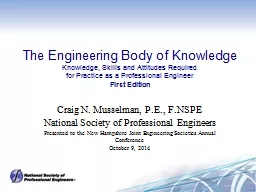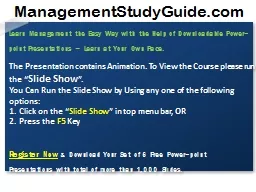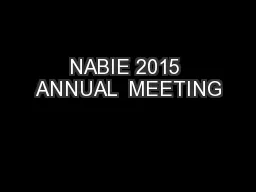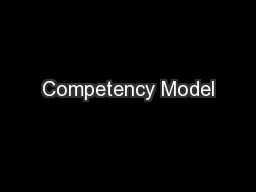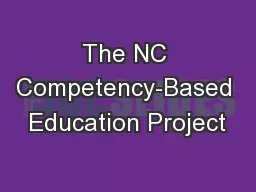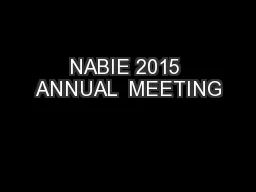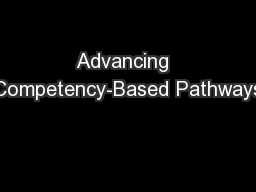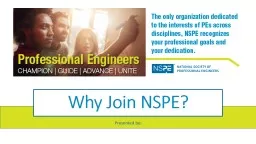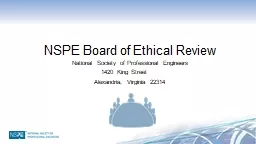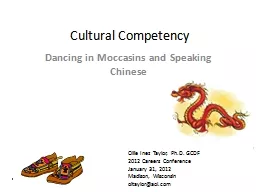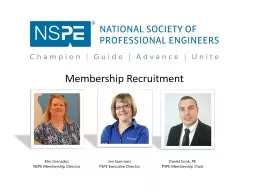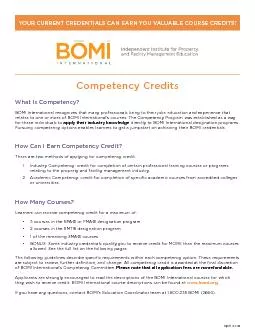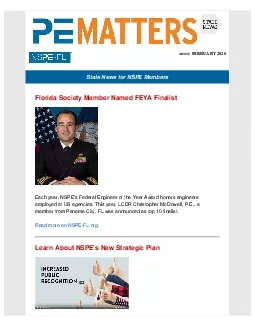PPT-NSPE EBOK Competency Model
Author : phoebe-click | Published Date : 2019-12-05
NSPE EBOK Competency Model Where Does It Fit What Does It Take to Be an Engineer Paul Schmidt PE FNSPE Chair NSPE Licensure and Qualifications for Practice Committee
Presentation Embed Code
Download Presentation
Download Presentation The PPT/PDF document "NSPE EBOK Competency Model" is the property of its rightful owner. Permission is granted to download and print the materials on this website for personal, non-commercial use only, and to display it on your personal computer provided you do not modify the materials and that you retain all copyright notices contained in the materials. By downloading content from our website, you accept the terms of this agreement.
NSPE EBOK Competency Model: Transcript
NSPE EBOK Competency Model Where Does It Fit What Does It Take to Be an Engineer Paul Schmidt PE FNSPE Chair NSPE Licensure and Qualifications for Practice Committee 20132015 NSPE Annual Meeting. HUMAN RESOURCE DEVELOPMENT. GROUP 3. PERSONNEL MANAGEMENT II. ROLL NO.. NAME. 03. Vishal. Vats. 12. Ankita. Kevin Natal. 25. Ruhama. . Kachchap. 35. Abhinav. . Mishra. 49. Hirni. . Pathak. 63. Ritesh. -. Learn at Your Own Pace.. The . Presentation contains Animation. To View the Course please run the “. Slide Show. ”.. You . Can Run the Slide Show by Using any one of the following options:. Click on the “. The Invisible, Professional Engineer. Tim Austin, PE, F.NSPE. President – Elect. National Society of Professional Engineers. Is Engineering Licensure still relevant in today’s economic world?. Engineers focus . GHS Nursing Initiative. All Nursing Roles. Staff (RN, UAPs). Preceptor. CNE. CNS. Manager. Director. Affiliated Faculty. . Faculty Competencies. PHASE. TARGET ROLLOUT. PURPOSE. Healthstream Curriculums. The NC-CBE Project. May 2017. What is Competency-Based Education?. Refocuses learning and teaching around outcomes. Uses . the application of learning, not time, as the sole means of determining progress towards degree . The Invisible, Professional Engineer. Tim Austin, PE, F.NSPE. President – Elect. National Society of Professional Engineers. Is Engineering Licensure still relevant in today’s economic world?. Engineers focus . To College and Career Readiness . March 19, 2014 | 3:00 – 4:00 pm. Presenters. 2. . State Leaders:. Sharon Lee, Director of Multiple Pathways, Rhode Island Department of Education. Paula Barney, Postsecondary and Workforce Readiness Specialist, Rhode Island Department of Education. NSPE’s Foundation. NSPE, in partnership with the State/Territorial Societies,. Serves as the recognized and authoritative expert in licensure, ethics, and professional practice; . Promotes licensure and assists individuals in becoming licensed; and. National Society of Professional Engineers. 1420 King Street . Alexandria, Virginia 22314. Today’s . presenters. Michael Aitken, P.E., F.NSPE. National Society of Professional Engineers. President-elect. Cultural Competency Dancing in Moccasins and Speaking Chinese Ollie Inez Taylor, Ph.D. GCDF 2012 Careers Conference January 31, 2012 Madison, Wisconsin oitaylor@aol.com C ultural Competency in reflecting on “ The Coming Racial Shift for the U.S.” NSPE Membership Director. Jen Summers. PSPE Executive Director. Daniel Cook, PE. PSPE Membership Chair. NSPE Focus. NSPE Focus. Recruitment. 2018-2019 Recruitment Plan. Recruitment. 2018-2019 Recruitment Plan. YOUR CURRENT CREDENTIALS CAN EARN YOU VALUABLE COURSE CREDITS!Competency Credits April 2019 Competency Credit ApplicationGeneral InformationYour name: BOMI ID#: eferred address: home business (If yo x0000x0000x0000x0000 FEBRUARY 2020State News for NSPE MembersFlorida Society Member Named FEYA Finalist Each year NSPE146s Federal Engineer of the Year Award honors engineersLearn About NSPE146s New S the Restoration Process. Peter . Tolisano, Psy.D., ABPP. Board Certified . in . Clinical Psychology. Director of Psychology. Connecticut Department of Developmental Services. Criminal Competency Points.
Download Document
Here is the link to download the presentation.
"NSPE EBOK Competency Model"The content belongs to its owner. You may download and print it for personal use, without modification, and keep all copyright notices. By downloading, you agree to these terms.
Related Documents

